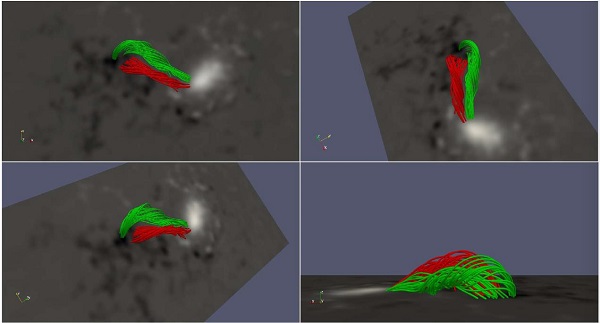Recently, a progress in the study of solar double-deck filament is achieved by ZHANG Yan, YAN Xiaoli et al. from Fuxian Solar Observatory, Yunnan Observatories, Chinese Academy of Sciences. The research results were published in The Astrophysical Journal.
Filaments are embedded in the solar corona, they are 100 times cooler and denser than the coronal material. The filaments that appear at the limb as bright features are called prominences, and those that appear on the disk, as a feature darker than their background are called filaments.
A double-decker filament as a very specific structure refers to two filaments vertically distributed above the same polarity inversion line. There are two possibilities for magnetic configuration of a double-decker filament: (1) Both the upper and lower branches are flux ropes; (2) The upper branch is the flux rope and the lower one is the sheared arcade. Up to now, the formation process of double-layer filaments is controversial. One view is that the formation of them is divided into two stages: first, the upper branch is formed above the polarity inversion lines, and then the lower branch emerges below it. The other is that a filament splits into two branches via internal magnetic reconnection.
The researchers used the multi-band data of the Solar Dynamics Observatory (SDO), the Hα image data of the Global Oscillation Network Group (GONG) to investigate the filament in the active region (AR) NOAA 12665 on 2017 July 8-14. The formation, evolution, splitting into a double-decker filament and the eruption of upper filament were studied in detail. Because of the photospheric magnetic motion and the magnetic reconnection, two small filaments are joined together to form a longer magnetic structure of the filament. Then, the newly formed filament splits into two branches and finally forms a double-decker filament.
Sunspot rotation, internal reconnections and the movement of the negative magnetic field were found to drive the filament split into two branches and finally form the double-decker filament. The internal reconnection can accelerate the separation of filaments. The researchers used non-linear force-free field (NLFFF) extrapolation to obtain the magnetic configuration of the filaments. According to the results of NLFFF extrapolation, the upper and the lower filaments are both magnetic flux ropes.
This work was sponsored by the National Science Foundation of China, by Yunnan Science Foundation for Distinguished Young Scholars and by Yunnan Key Laboratory of Solar Physics and space science.
Contact:
YAN Xiaoli
Yunnan Observatories,CAS
Email: yanxl@ynao.ac.cn

Figure 1. The magnetic structures of the double-decker filament from non-linear force-free field (NLFFF) extrapolation